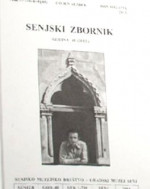Obnova Gradske vijećnice – lože u Senju. Rezultati zaštitnih arheoloških istraživanja na lokaciji Gradske vijećnice – lože
Renewal of the town hall - loggia in Senj. The results of protective archaeological research of the location of the town hall - loggia
Author(s): Blaženka Ljubović, Damir MartinovSubject(s): Archaeology, Regional Geography, Ancient World, 13th to 14th Centuries
Published by: Senjsko muzejsko društvo i Gradski muzej Senj
Keywords: Senj; town hall – loggia; building repairs and reconstruction of the supporting structure; archaeological research; wall; brick; floor; tiling;
Summary/Abstract: In the past few years phases in the repair and reconstruction of the town hall – loggia have been carried out with the aim of the renewal and consolidation of the building and the removal of all earlier destruction and building interventions to the external wall and the interior of the loggia, in order to return it to its original appearance. Since this concerns a cultural monument of the highest category, the renovation and building repairs, before the performing of restoration-architectural works, required a making technical and design documentation in the form of which is foreseen the implementation of conservation, geo-mechanical, geostatic and protectivearchaeological research in order to make the appropriate technical documentation – studies –elaborations.The mentioned conservation investigations served as a basis for the making of a conservation study and a project of the stonemasonry details of the city’s loggia and the conceptual and main project of the reconstruction of the architecture and repair and reconstruction of its supporting structure whilst the protective archaeological research is carried out for the purpose of collecting all the important information about the cultural layers and archaeological movable and immovable findings over the structure’s area. The area of the archaeological research is located in the basement of the loggia the construction of which is based on historical sources dating to the 14th century. The building is situated within the walls of mediaeval Senj and inside the city areal of ancient Senia. The surface area of the research covers a little less than 50 m2. Archaeological inspection of the works in the city’s loggia has been present since the beginning of the works, whilst detailed archaeological research in its basement were carried outduring October, November and December of 2011. These have shown that the basement of the mediaeval city loggia’s original function was as a ground floor. The street levels which flank the loggia from the east and south sides over time rose 1 to 2 metres due to the intensive city life. This phenomenon is common in cities which over long periods had a distinctly urban character. This also affected the adaptations which were made on the walls of the hall. With time it certainlyappeared necessary that at first the southern entrance, and then the window openings of the east and north side should also be closed, with which the initial ground floor building became a basement space more or less unchanged from what we recognise today. The majority of the remodelling differs from the original parts of the walls because when building besides bricks stone was also used. The technique of brick building was identical to the earliest Romanesque elements of the construction seen on the outer skin of the building after the removal of the façade. With the removal of the floor of the basement and layers directly underneath it were discovered the remains of a wall which based on the technique of construction can be interpretedas being from the Roman period. It is the north-west corner of some structure, oriented in an approximately NW-SE direction. The remains of the structure similar to tiling discovered in the central area cannot be determined with certainty in a functional or in chronological sense.We are hoping that after the overall repair and reconstruction of the town’s loggia known as Kampuzij, a characteristic element of mediaeval towns of the Mediterranean, which is located in the historical heart of the city of Senj according to the concept of the same project, to acquire the intended museum space which it deserves and the carrying out of exhibition-gallery activities inthis renovated space. With this restoration a significant monument of culture for the City of Senj will be saved, which will contribute to the general renewed impression of the city, its importance in the past, aswell as being a monument to the past it will contemporaneously enrich the visual, cultural-history as well as adding to the tourist attractiveness.
Journal: Senjski zbornik - prilozi za geografiju, etnologiju, gospodarstvo, povijest i kulturu
- Issue Year: 40/2013
- Issue No: 1
- Page Range: 209-254
- Page Count: 46
- Language: Croatian

